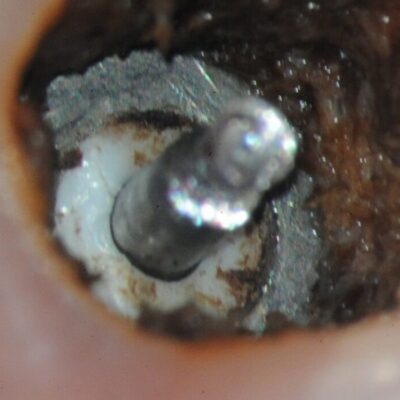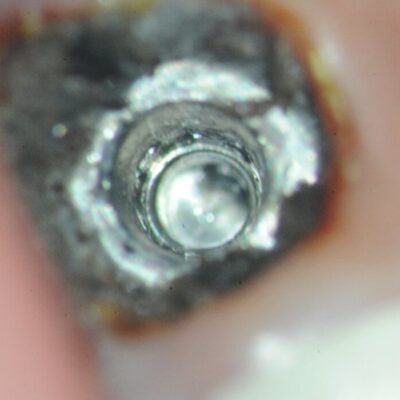The patient reported as scheduled and the recovery process was explained to her. According to the patient, the restored implant had been in function for approximately 6 months when she reported crown looseness. As it was difficult for the general office to ascertain the exact cause of the problem, she lived with the loose crown for another two months prior to the referral to my office. It is unclear if the crown was ground off leaving the abutment screw intact or if it fractured away from the screw.
One carpule of Septocaine was infiltrated and a small amount of excess tissue overgrowth was removed to expose the top of the implant and abutment screw. It was immediately apparent this was a fractured zirconia abutment as visualized in the preoperative microscope photograph. In this case, the abutment distraction tools will not work as it is impossible to tap threads into the zirconia. Therefore, the only course of action would be to: 1. use the floating abutment screw to distract the retained conus as the through bore is smaller than the thread basket or: 2. Clear the through bore and either “wobble” the abutment out or carefully grinds it out using microscope assistance. As this is the first Ankylos case I have seen with an intact abutment screw, the idea of using it for distraction was a clinical thought during the appointment when the wobbling tool was unsuccessful. Potentially it could be a quick solution to distract the conus fragment if the screw would stay intact under the distraction force, which is somewhat doubtful. As prototype tooling was not available to test this random idea and the wobbling tool was ineffective, a total grind out was initiated. Using constant microscope vision, the conus walls were thinned with a round course diamond until the walls had paper thin sections. Next using a modified small root tip pick and mallet, the thin zirconia sections were fractured and removed from the implant walls. Once the conus was cleared, the indexing zirconia and screw fragment was addressed. To unlock the combination of zirconia and screw fragment the screw was reduced down further with a surgical length 56 high speed bur again using microscope guidance. Once the screw shaft was clear, the zirconia was in fractured and removed. The screw fragment now became mobile and easily delivered using a surgical length ¼ round bur on the OD of the screw shaft. The implant was confirmed to be clear and an Ankylos healing abutment was placed finger tight. The total office time for completion was 2 hours. Following the procedure, a short discussion was completed with the patient showing her the photos and explaining the new abutment should be titanium for additional strength hopefully to avoid a repeat failure in this site. The patient was very pleased with the outcome.
06-10-2022 Dr. Charles A. Mastrovich














